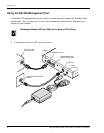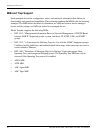
Chapter 10: Technical Reference
Megabit Modem 400F, 500L, 600F, and 700F User Manual 87
SYSTEM MODE ENCAPSULATION
Point-to-Point Protocol (PPP) over ATM or RFC 1483 Bridging/Routing are the two protocols
you can use to encapsulate data for transport across the ADSL WAN. The following sections
describe these protocols.
PPP
PPP runs over ATM virtual circuits. PPP exists between the hardware layer and the
network-layer interface protocols. It is a widely used protocol for establishing connections on
the WAN. PPP provides the set up and release of connections for each session. PAP/CHAP
provide the authentication for the PPP sessions.
In PPP over ATM mode, you can map private IP address LAN users to PPP sessions using RFC
1631 Network Address Translation protocol.
PAP/CHAP Authentication Security
Password Authentication Protocol (PAP) and Challenge-Handshake Authentication Protocol
(CHAP) are two ways to authenticate PPP sessions. PAP and CHAP are both offered since some
systems support only PAP. With PAP, the modem sends authentication requests to the service
provider and authentication occurs only once during the life of the link.
With CHAP, the service provider returns an authentication challenge to the modem during
authentication. CHAP can be renegotiated during the life of the link. Also, both the modem and
the service provider must support clear text versions of the password. The CHAP host field must
be the same on both ends of the session.
NAT
RFC 3022 Network Address Translation (NAT) includes two operations. They are Basic NAT
and Network Address Port Translation (NAPT).
Basic NAT only deals with IP addresses. Therefore, it is a one-to-one private IP address to
public IP address (proxy address) mapping. Basic NAT allows you to hide your private
addresses behind the public IP addresses assigned to a session. Corporations that need flexibility
using different IP address ranges can benefit from this operation, as the private IP addresses will
remain the same when the public IP addresses are reassigned.


















